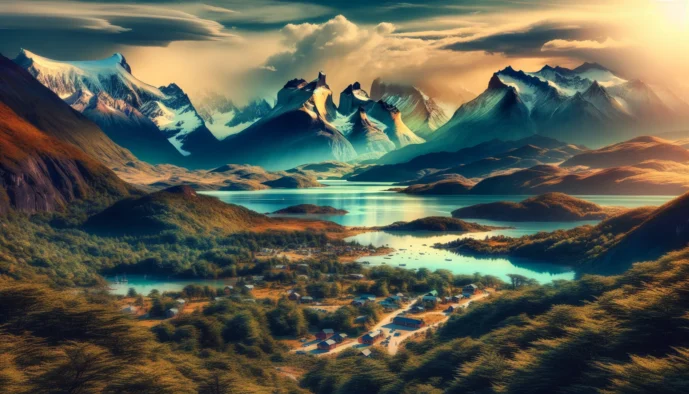Patagonia’s History: A Tale of Two Nations and a Wild Frontier
Explore the rich history of Patagonia, covering its stunning landscapes, indigenous cultures, and historic explorations.

Patagonia, a vast and rugged region shared by Argentina and Chile, has a rich and complex history shaped by indigenous cultures, European colonization, and the struggles of two nations to claim and develop this remote land. To understand Patagonia’s history, it’s essential to explore the broader histories of Argentina and Chile, as well as the unique story of this southern frontier
Essentials
Patagonia, a vast and rugged region shared by Argentina and Chile, has a rich and complex history shaped by indigenous cultures, European colonization, and the struggles of two nations to claim and develop this remote land. To understand Patagonia’s history, it’s essential to explore the broader histories of Argentina and Chile, as well as the unique story of this southern frontier.
A Brief History of Argentina
Pre-Colonial Era
- Before European arrival, Argentina was inhabited by indigenous peoples such as the Guaraní, Quechua, and Mapuche. These groups lived in diverse regions, from the fertile Pampas to the Andean highlands.
Colonial Period
- In 1516, Spanish explorer Juan Díaz de Solís became the first European to reach Argentina. The Spanish established Buenos Aires in 1536, but it was abandoned and later refounded in 1580.
- Argentina became part of the Viceroyalty of Peru and later the Viceroyalty of the Río de la Plata in 1776. Buenos Aires grew as a key port for trade.
Independence and Nation-Building
- Argentina declared independence from Spain on July 9, 1816, led by figures like José de San Martín.
- The 19th century saw internal conflicts between federalists and unitarians, as well as the expansion of agriculture and European immigration, which shaped Argentina’s cultural and economic identity.
Modern Argentina
- The 20th century was marked by political instability, including the rise of Juan Perón and periods of military dictatorship. Today, Argentina is a democratic nation with a strong cultural identity and a mixed economy.
A Brief History of Chile
Pre-Colonial Era
- Chile was home to indigenous groups like the Mapuche, Aymara, and Rapa Nui (Easter Island). The Mapuche, in particular, were known for their resistance to outside domination.
Colonial Period
- Spanish conquistador Pedro de Valdivia founded Santiago in 1541, establishing Chile as part of the Spanish Empire. The Mapuche fiercely resisted Spanish colonization in a conflict known as the Arauco War.
Independence and Nation-Building
- Chile declared independence from Spain on September 18, 1810, with leaders like Bernardo O’Higgins and José de San Martín playing key roles.
- The 19th century saw territorial expansion, including the War of the Pacific (1879–1884), which gave Chile control of nitrate-rich areas in the north.
Modern Chile
- The 20th century was marked by political polarization, culminating in the 1973 coup and the dictatorship of Augusto Pinochet. Since the return to democracy in 1990, Chile has become one of South America’s most stable and prosperous nations.
The History of Patagonia
Indigenous Peoples
- Patagonia was originally inhabited by indigenous groups such as the Tehuelche, Selk’nam (Ona), and Yámana. These nomadic tribes adapted to the harsh environment, relying on hunting, fishing, and gathering.
European Exploration
- The first European to explore Patagonia was Ferdinand Magellan in 1520, who named the region after the mythical “Patagón” giants. Later explorers like Francis Drake and Charles Darwin documented the region’s geography and indigenous cultures.
Colonial Struggles
- Both Spain and later Argentina and Chile claimed Patagonia, but the region remained largely untouched due to its remoteness and harsh climate. The indigenous peoples resisted colonization, but their populations declined due to disease, warfare, and displacement.
The Conquest of the Desert
- In the late 19th century, Argentina launched the Conquest of the Desert (Conquista del Desierto), a military campaign to subdue indigenous tribes and claim Patagonia for settlement. This led to the near-extermination of the indigenous population and the opening of the region to European immigrants.
Chilean Expansion
- Chile also sought to assert control over Patagonia, particularly in Tierra del Fuego. The 1881 Boundary Treaty between Argentina and Chile established the current border, though disputes over specific areas continued into the 20th century.
Modern Patagonia
- In the 20th century, Patagonia became a focus of economic development, including sheep farming, oil extraction, and tourism. Today, it is known for its stunning landscapes, national parks, and eco-tourism opportunities.
Patagonia’s Cultural Legacy
Environmental Awareness: Patagonia is now a global symbol of conservation, with efforts to protect its unique ecosystems and wildlife.
Indigenous Heritage: Despite the devastating impact of colonization, efforts are being made to preserve and honor the cultures of the Tehuelche, Selk’nam, and Yámana peoples.
European Influence: The region’s culture reflects the influence of Welsh, Scottish, and other European immigrants who settled in Patagonia in the 19th and 20th centuries.